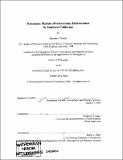Kinematic models of interseismic deformation in Southern California
Author(s)
Meade, Brendan J. (Brendan Joseph), 1975-
DownloadFull printable version (14.82Mb)
Other Contributors
Massachusetts Institute of Technology. Dept. of Earth, Atmospheric, and Planetary Sciences.
Advisor
Bradford H. Hager.
Terms of use
Metadata
Show full item recordAbstract
We develop a framework for interpreting geodetic measurements of interseismic deformation and geologic slip rate estimates in terms of block motions. This method accounts for the effects of block rotations and interseismic strain accumulation from active fults. We find that the San Andreas Fault slips close to Its Holocene rate in the Carrizo Plain (35.6 [plus-minus] 0.5 mm/yr) but is five times slower near San Bernadino (6.6 [plus-minus] 2.7 mm/yr). Thrust faults underneath Los Angeles, the Ventura Basin, and the San Gabriel range front all exhibit active shortening from 0.5 to 13.5 mm/yr. We suggest that differences between paleoseismic and block model slip rate estimates may be explained by changes in fault slip rates through the Holocene. The viscoelastic rheology of the non-brittle upper lithosphere may give rise to time dependent surface deformation though the seismic cycle. We extend a classic theory from periodic to temporally clustered earthquakes by superposing several out of phase earthquake cycles. This new model displays a much wider range of behaviors than does the periodic earthquake cycle model and provides a mechanism to explain apparent discrepancies between geologic and geodetic slip rate estimates. The potential for large earthquakes in an active fault system is determined by the balance between coseismic moment release and interseismic moment accumulation. We identify regions of local moment deficit in Southern California by comparing historical earthquake catalogs with the fault slip rate catalogs derived from both geologic and geodetic data. Large moment release deficits are localized in the northern Mojave Desert, San Jacinto fault, San Andreas fault, and the greater Los Angeles area. We estimate the (cont.) minimum size earthquake sources (M > 7) required to relieve these deficits.
Description
Thesis (Ph. D.)--Massachusetts Institute of Technology, Dept. of Earth, Atmospheric, and Planetary Sciences, 2004. Includes bibliographical references.
Date issued
2004Department
Massachusetts Institute of Technology. Department of Earth, Atmospheric, and Planetary SciencesPublisher
Massachusetts Institute of Technology
Keywords
Earth, Atmospheric, and Planetary Sciences.